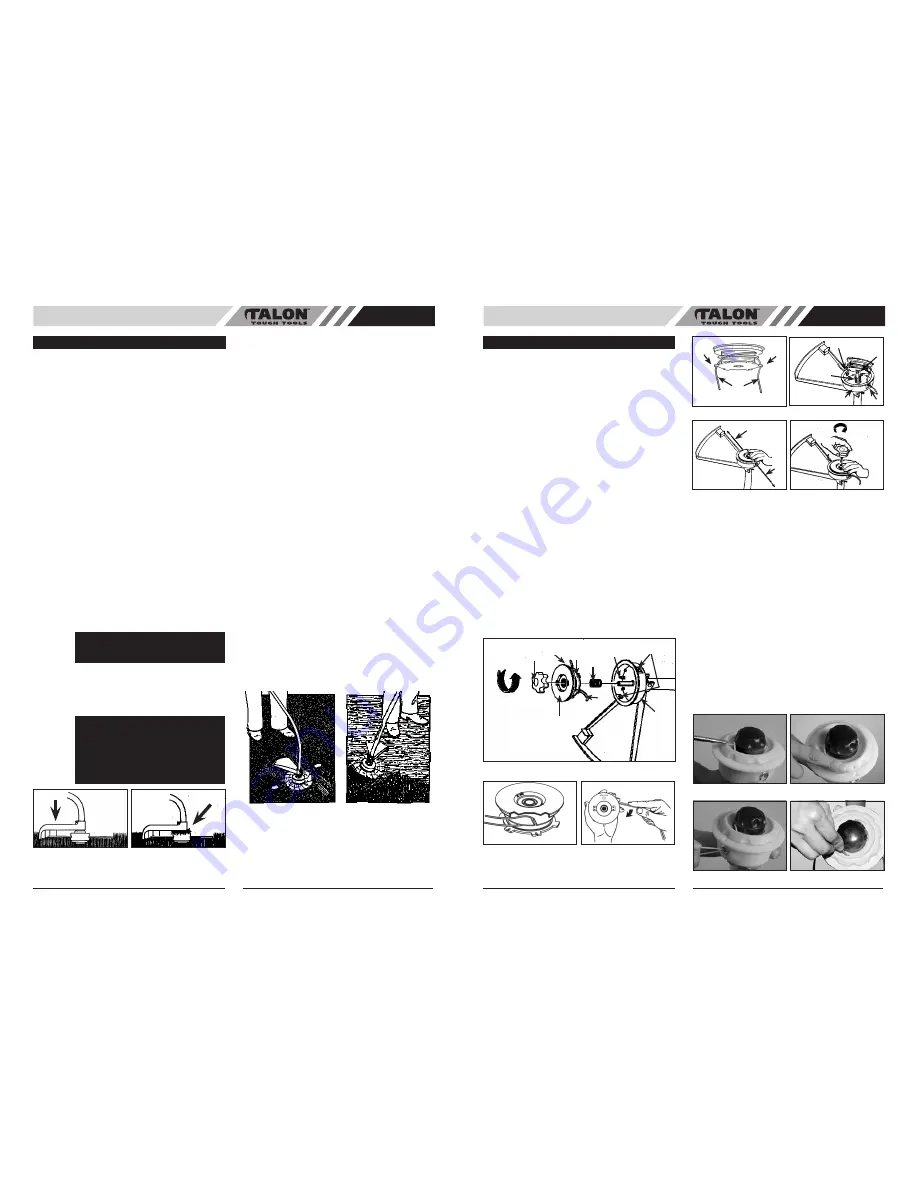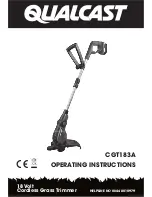
AU
9
• ADDITIONAL SAFETY PRECAUTIONS
Before operating your unit, review ALL SAFETY
PRECAUTIONS in this manual.
WARNING / CAUTION
• IF UNFAMILIAR WITH TRIMMING techniques, practice
the procedures with ENGINE in “OFF” position.
• ALWAYS CLEAR WORK area of debris such as cans,
bottles, rocks, etc. Striking objects can cause serious
injury to operator or bystanders and also damage
equipment. If an object is accidentally hit, immediately
TURN ENGINE OFF and examine equipment. Never
operate unit with damaged or defective equipment.
• ALWAYS TRIM OR CUT AT HIGH ENGINE SPEEDS.
Do not run engine slowly at start or during trimming
operations.
• DO NOT use equipment for purposes other than
trimming or mowing weeds.
• NEVER raise linehead above knee height during
operation.
• DO NOT operate unit with other people or animals
in the immediate vicinity. Allow a minimum of 50 feet
(15 meters) between operator and other people and
animals when trimming or mowing.
• Allow a distance of 100 feet (30 meters) between
operator and other people and animals when SCALPING
with linehead cutter.
• IF OPERATING UNIT ON A SLOPE, stand below the
cutting attachment. DO NOT OPERATE on a slope or
hilly incline if there is the slightest chance of slipping or
losing your footing.
• LINEHEAD LINE RELEASE
To release fresh line, run engine at full throttle and “bump”
linehead against lawn. Line will automatically release. The
knife in debris shield will trim excess line (Fig. 6A).
• TRIMMING PROCEDURES
When properly equipped with a debris shield and linehead,
your unit will trim unsightly weeds and tall grass in those
hard-to-reach areas - along fences, walls, foundations and
around trees. It can also be used for scalping to remove
vegetation down to the ground for easier preparation of a
garden or to clean out a particular area.
NOTE:
Even with care, trimming around foundations, brick
or stone walls, curves, etc., will result in above normal
line wear.
TRIMMING / MOWING
Swing trimmer with a sickle-like motion from side to side.
Do not tilt the linehead during the procedure. Test area
to be trimmed for proper cutting height. Keep linehead at
same level for even depth of cut (Fig. 7A).
CLOSER TRIMMING
Position trimmer straight ahead with a slight tilt so bottom
of linehead is above ground level and line contact occurs
at proper cutting point. Always cut away from operator. Do
not pull trimmer in toward operator.
FENCE / FOUNDATION TRIMMING
Approach trimming around chain link fences, picket fenc-
es, rock walls and foundations slowly to cut close without
whipping line against the barrier. If the line comes in con-
tact with rock, brick walls, or foundations, it will break or
fray. If line snags fencing, it will snap off.
TRIMMING AROUND TREES
Trim around tree trunks with a slow approach so line does
not contact bark. Walk around the tree trimming from left
to right. Approach grass or weeds with the tip of the line
and tilt linehead slightly forward.
SCALPING
Scalping refers to removal of all vegetation down to the
ground. To do this, tilt the linehead to about a 30 degree
angle to the left. By adjusting the handle you will have
better control during this operation. Do not attempt this
procedure if there is any chance flying debris could injure
operator, other people or cause damage to property. (Fig.
7B)
TRIMMING INSTRUCTIONS
WARNING:
DO NOT use steel wire or plastic-
coated steel wire of any kind with your line-
head. Serious operator injury can result.
CAUTION
: Periodically remove weed wrap
to prevent overheating the drive shaft. Weed
wrap occurs when strands of weed become
entangled around the shaft beneath the
debris shield (Fig. 6B). This condition pre-
vents the shaft from being properly cooled.
Remove weed wrap with screwdriver or
similar device.
Fig. 6A
Fig. 6B
BUMP
Fig. 7A
Fig. 7B
• REPLACING TRIMMING - LINE STANDARD
HEAD (AT33581)
1. Turn knob (A) COUNTERCLOCKWISE and remove
(Fig. 8A). User knob spanner supplied.
2. Remove spool (B) and spring (C) from spindle (D).
3. Remove any remaining cutter line (H).
4. Double a 14' (4.3m) length of .080" (2mm) cutter line.
Place the looped center in one of the slots of the
spool divider (Fig. 8B).
5. Wind cutter line clockwise as shown in illustration
(Fig. 8C), keeping tension, with each half separated
by the spool divider. Wind to within 6" (15cm) of the
ends.
6. Lock each end of line (H) into a slot (F) on opposite
sides of the spool (Fig. 8D).
7. Install the spring (C) over the spindle (D). Insert each
end of the line through an eyelet (G) in the housing
(E) (Fig. 8E).
8. Lower the spool into the housing (E) while feeding the
line through the eyelets (G). Ensure the spring seats
itself into the spool (Fig. 8E).
9. Once the spool is in place, apply pressure on the spool
compressing the spring. Pull each end of the line (H)
sharply to unlock the line from the slots (Fig. 8F).
10. Continue to apply pressure to the spool until the
knob can be threaded CLOCKWISE onto the spindle.
Tighten the knob securely by hand only (Fig. 8G).
11. Trim the excess line to approximately 5" (13cm).
This will minimize load on engine during starting and
warm-up (Fig. 4A).
•
REPLACING TRIMMING LINE-EASY-LOAD
HEAD (AT33582)
1. Use a small screwdriver or pointed rod to release line
from locking holes. (Fig. 9A)
2. Remove remaining line from head.
3. Align arrows on inner and outer spool.(Fig. 9B)
4. Cut a length of trimming line approximately 5 meters
long.
5. While pushing inner spool down insert each end of
line through eyelets into feed slot on spool divider.
Ensure line enters feed slots. Push line until approxi-
mately 5 cm appears from below bump knob.(Fig.
9C)
6. Insert each end into locking hole. Pull line at eyelet to
tension. (Fig. 9D)
7. Once both line ends are locked in place turn inner
spool counter clockwise in direction of arrows to load
line. (Fig.9E)
8. Wind spool until a loop of line approximately 25cm
long is visible. Cut loop in half to create two cutting
line ends. Ensure each line end is not more than
13cm long. This will minimize load on engine during
starting.
10
AU
MAINTENANCE INSTRUCTIONS
Fig. 8B
Fig. 8C
A
B
C
D
E
F
H
H
G
Fig. 8A
A. KNOB
B. SPOOL
C. SPRING
D. SPINDLE
E. HOUSING
F. SLOTS
G. EYELETS
H. CUTTER LINE
Fig. 8D
Fig. 8E
H
F
F
Fig. 8F
Fig. 8G
H
H
Fig. 9A
Fig. 9B
Fig. 9C
Fig. 9D
G
D
G
E
C
























